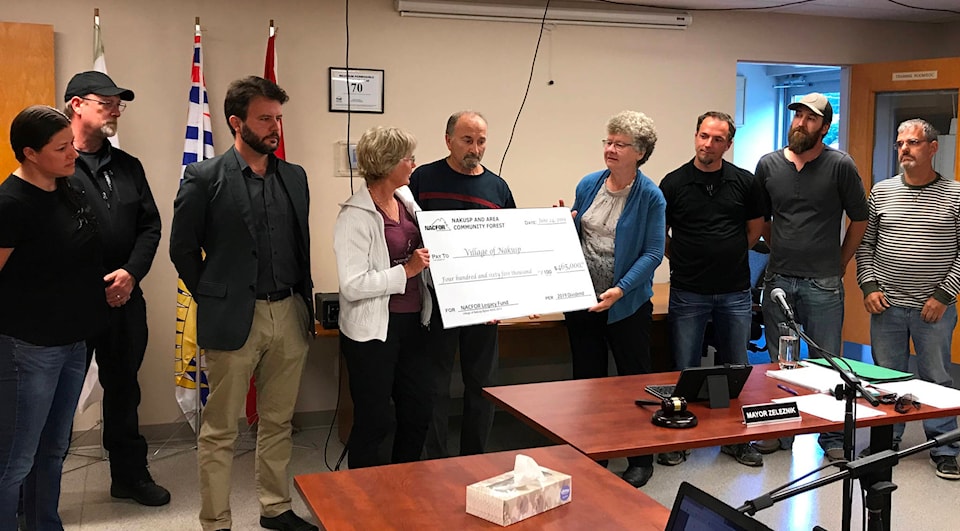Owning your own forestry company paid off big this year for the Village of Nakusp.
The Nakusp Community Forest (NACFOR) recently declared a dividend of $465,000 to the municipal government.
“I’m proud to be able to declare a dividend and present the money to the shareholder, the Village of Nakusp, so those moneys can be used for local benefit,” said NACFOR president Kathy Smith.
Smith and an entourage of NACFOR staff hand-delivered a cheque to village council at its last meeting.
The dividend was the second-largest by the community-owned forestry company. The largest, over $582,000, was given to the village in 2014.
In all NACFOR has given more than $1.5 million to the community since it was formed in 2008.
Smith says a solid year in 2018 led to the big bonus check for the village.
“Basically because our operations were successful, based upon planning, management, markets, and marketing, and costs,” she says.
For the village, it’s an amazing contribution to the municipal coffers — almost half as much as the village raises through taxes. To generate the same amount of money through property taxes, council would have had to raise them more than 45 per cent this year.
“We rely heavily on grants to do our village work, so any little bit helps,” says Mayor Tom Zeleznik. “Knowing we have something from NACFOR is immensely helpful.”
However, the bylaw governing the relationship between the village and the community forester stipulates the money can’t be used for day-to-day village business, or reducing taxes.
“Right now we’ve done our budget, so nothing will happen this year,” Zeleznik says. “But we can look at ways to improve our community. What we’ll do is sit down and look at the village’s priorities, and see where the grant can go.”
In recent years, the money has gone to special projects like repairing the community complex roof, and supporting the big revitalization project downtown.
“The village has used the money for leveraging other money for community support,” says Smith. “When you can use it to get more money for things like the arena roof and downtown revitalization, it just means your money is working harder.”
Money for RDCK
The village isn’t the only beneficiary. The RDCK’s Area K has one-quarter of the dividend set aside for its purposes. The money’s been used to build new fire halls in Burton and Edgewood, improve a golf course in Fauquier, and other projects.
On top of the dividend, NACFOR also gives up to $50,000 to local charitable organizations annually, and supports local schools for educational purposes.
“This is a community forest and this is giving back to the community, trying to keep the profits local, and trying to hire local as much as we can,” says Smith. “And that’s the thing with the community forest, it keeps the proceeds from the forest local.”
But in the volatile world of forestry, there’s no guarantee NACFOR will have a dividend for the village next year.
“Some years we can’t make a dividend declaration because we spent a lot of money in development and layout for future operations,” she says. “It’s not a straight-across-the-board thing where every year there’s a dividend that can be declared. We have unforeseen expenses, things that take you into different directions, like having to invest in road-building or bridge-building, or maybe you can’t log because of the fire season.”
Smith says they’re not expecting such a rosy return next year.
“We’ve had some operations ongoing since winter, but there’ll be a bit of a lag because of fire season,” she says. “We’re not forecasting a huge, if any, profit this year. It depends how things are going — this year we’ve had mill shutdowns, and market changes.
“So we know this will be a ‘down’ year for sure.”
Even if there’s no dividend next year, Zeleznik points out the other ongoing benefits of NACFOR.
“The advantage of a community forest is it’s long-term economic development, and it helps in building self-reliance for our community,” he says. “It boosts the local economy, and there’s local employment. You have local-level decision-makers making locally-appropriate decisions. And you get a company that has the incentive to consider the long term benefits of sustainable management.”
